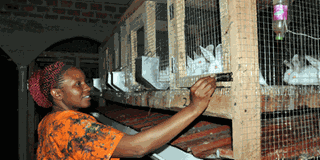Prime
Nantale finds joy in rabbits and quails

Nantale (L) feeds rabbits and collects quail eggs. PHOTOs BY EDGAR R. BATTE
My name is Jessica Nantale. Before I started rearing rabbits and quails, I worked with several companies but I felt my talent and resources were under-utilised. In 2012, I watched a video about rabbit farming, I was impressed and found out more about it.
Rabbits are reared on a large scale in countries like Kenya, India, US among other countries.
I shared the idea with my business partner, Simon Tebyasa, who was in the US at the time. He visited several rabbit farms to see how it is done. He learned the basics and shared the knowledge with me
We had a 200 feet by 100 feet piece of land at Buloba along Mityana road, where I had been growing mushrooms and rearing poultry. It was on this land that we started rabbit farming as a pilot project.
Important things
We started with 25 exotic rabbits: 22 females (does) and three males (bucks). We bought some from Kenya at KShs4,000 (Shs 118,272) each and 10 New Zealand Whites from a rabbit breeder who is based in Buloba. These ones cost Shs40,000 each.
After three months, 12 of them produced an average of seven kittens or kits each. Since then, the number had been gradually increasing to our current stock of 200 rabbits.
This figure excludes those we have sold to other farmers. All this within a period of two years.
The price of a rabbit depends on the breed and weight. They range between Shs40,000 and Shs80,000 although some indigenous breeds are sold between Shs10,000 and Shs20,000 depending on where and who is selling.
In a few supermarkets, where the meat is sold, a kilo goes for Shs9,000 to Shs15,000. We mostly sell to other farmers who like the exotic breeds but we also get inquiries about the meat, which we hope to begin supplying in a couple of months.
Caring for rabbits does not require a lot of labour. The most important things to take note of are: maintaining a clean place, good record keeping, making sure there is enough clean drinking water, and ensuring that any sick rabbit is isolated from the rest.
Significant gains
Does are ready to breed at four to six months while bucks are ready at five to six months. A single rabbit can have up to 14 kittens per litter with a gestation period of 28-31 days.
For instance, if a farmer starts out with three female rabbits and keeps them for three years, the population will have grown significantly thus attracting a lot of money.
The housing is the biggest expense. Otherwise, the cages can be made using timber and wire mesh, which are available at hardware shops.
Starting the rabbit farm required some capital investment so we borrowed money from the bank. The loan has been paid off and the farm is expanding, so if we are to calculate the earnings, some money has been made. We have two employees but we intend to hire two more by end of the year.
First batch
When we decided to rear quails, it was difficult to get parent stock since quail farming is still a new thing and few people are involved in it.
We imported a batch of 1,500 fertilised eggs from US and Kenya. With all the logistics and paper work involved, we spent a total of $2,000 (about Shs5.2m).
It was not easy to import eggs because they are fragile. We lost money with this first batch of eggs since many did not hatch due to the time they spent in transit.
We had to get a licence from Uganda Wildlife Authority (UWA) since quails are considered a wild bird in Uganda. The process of getting the licence from UWA took a lot of time. It required patience on our part and we had to move around a lot. They even had to visit and inspect the site where we were going to set up the farm.
However, it was a disappointing hatch and we almost gave up. We then invested in putting up brooders and cages for the quails. If not put in cages with the right dimensions, they fly into the walls, hurt themselves and die.
The cost of labour to make the cages was minimal since we used timber and wire mesh, which are locally available materials.
Although in many countries around the world quail farming has been a practice for so many years, in Uganda it a new thing hence awareness is still poor so that comes with challenges.
Rewarding
There are more than 18 quail breeds around the world but we specialise in American Jumbo Brown and Texas A&M breeds because they perform well in our climate. We plan to introduce other breeds with guidance from UWA.
Rearing quail birds is rewarding because in just four months, we were able to recoup the money we initially invested. We have been able to increase parent stock from 300 to 2,000 birds.
Every week, we hatch between 500 and 1,000 quails. Most of our clients want to buy day-old chicks.
Pricing for quail eggs has been based on demand. We sell eggs at Shs800 each for fresh ones and Shs1,400 each for the fertilised ones, which are ready to be incubated. This is for those who want to hatch their own quail chicks.
We sell eggs in raw form but we plan on importing a machine to make powdered eggs to increase the shelf life.
Also, as we expand and are able to collect enough quail droppings, we will be packing it for sale as fertiliser.
The biggest cost to a quail farmer is the initial capital to buy eggs or the quails, and the cages and feeds. Each quail feeds on about 17 grams per day and that is about Shs25 to Shs30 per bird per day compared to about Shs230 to Shs250 that one would spend on feeding a hen per day. This relatively makes feeding quails cheaper.
Growing customer base
The profit margin is substantial as quails occupy less space and eat less. Based on the financial and nutritional benefits of quails and quail eggs, we encourage more people to rear quails.
We chose to rear rabbits and quails because they do well in a small space are not labour intensive and the returns are high.
Even with a small land size, one can earn a lot from an agricultural enterprise like quail farming. Our initial customers were mainly friends and family members and of course eating quail eggs became part of our diet.
Over time the customer base has grown significantly. We get inquiries from across the country and other countries—Rwanda, Congo and Sudan.
We have taught other farmers how to rear quails. We receive five to 10 prospective quail farmers a week as they visit the farm to observe and learn the basics. Most of them are youth and women although men have also showed interest.
A few factors why quail birds is easier to rear
Quails are small-sized bird and come in different colours including white. An adult quail weighs between 150 to 200 grams and an egg weights seven to 15 grams.
Female quails start laying eggs at six to seven weeks of age and continue to lay an egg daily.
They lay about 300 eggs in the first year. After that they produce about 150 to 175 eggs in second year. Egg production gradually decreases after this.
Quail egg is suitable for human consumption. It contains 2.47 per cent less fat than chicken egg.
Domesticated quails do not incubate their eggs. So you have to use an incubator or brooder chickens for hatching their eggs.
Quail meat is tasty, nutritious and low in fat.
Nantale on the dos and donts of rearing rabbits and quails
feeding rabbits
Although rabbits will eat almost everything that grows in the soil, but you should be careful with what you feed your rabbits on.
We feed our rabbits on pellets and supplement that with some grasses like lablab, Timothy grass and sometimes carrots as a treat. If bred and fed right, rabbits can attract a good commercial value of up to Shs100,000 based on its weight and breed.
The feeds consumed depend on age, weather, health and amount of exercise the rabbits get.
Of course, it is good common sense not to overfeed the rabbits. The basic rule is to feed each rabbit one ounce of pellet per pound of body weight. For example, a two-pound rabbit would eat about two ounces or a quarter of a cup per day. This translates to about Shs80 a day based on the cost of pellets.
We wish the price of rabbit feed would go down such that most Ugandans can afford to buy rabbit meat.
care and management
If kept right, rabbits are not as delicate as people think. They are very clean animals that require a clean environment.
What we know is that rabbits will get sick if left in a dirty place and they require a lot of clean drinking water as a big percentage of their bodies are made of water.
In Uganda, people have not yet discovered the benefits of rabbit products and the government has not done enough in sensitising farmers about the benefits of rabbit farming.
Also, the cost of feed (pellets) is very high so the best way to save is to alternate between feeding rabbits with grass and pellets.
Advantages of quails
-Quails are small-sized birds so they can be raised within small place.
- Feeding costs are comparatively lower than those of chicken or other poultry birds.
-Diseases are less frequent in quails, and they are very hardy.
-They grow very fast and gain maturity faster than other poultry birds.
-They start laying eggs at six to seven weeks.
- It takes 16 to 18 days to hatch their eggs.
- Meat and eggs are tasty and nutritious. A good source of food and nutrition.
- Quail farming needs small capital, and labour costs are low as one person can manage 5,000 birds
-Quails can be successfully raised on a commercial basis.
Quail eggs
The eggs have nutritional benefits for people that have health problems according to research conducted by scientists around the world.
Some say that the quail egg should be pronounced a “super food”.
It has been proved to contain Vitamin B6, B12 and D, iron, magnesium , zinc, copper, phosphorous and other essential micro-nutrients, minerals and amino acids.
That is why quail eggs are recommended for regular consumption.
Because of their nutritional values, they have been attributed to health improvements in people with certain ailments like asthma, skin rash, allergies, gastric ulcers, poor digestion, excess secretion of stomach acids, anaemia, growth stimulation, diabetes, and gout.
Research is ongoing about other diseases. But we encourage people to continue with their medication because a quail egg is not classified as a medicine but a supplement.




